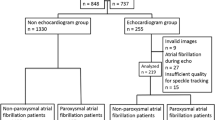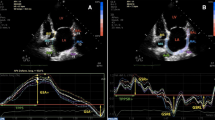Abstract
Twenty-five percent of ischemic strokes (IS) are cryptogenic, but it is estimated that paroxysmal atrial fibrillation (PAF) is the underlying cause in up to a third of cases. We aimed to investigate the predictive value of speckle tracking of the left atrium (LA) in diagnosing PAF in IS patients. We retrospectively studied 186 IS patients with a clinical echocardiographic examination during sinus rhythm. Outcome was PAF defined by at least one reported episode of AF following their IS. Conventional echocardiographic measures were performed. Global longitudinal strain (GLS), LA reservoir-(εs), conduit-(εe), contraction-strain (εa) and LA dyssynchrony (standard deviation of time-to-peak εs; LA SD-T2P) were obtained by left ventricular and LA speckle tracking. Of 186 patients, 28 (15%) were diagnosed with PAF. PAF-patients did not differ from non-PAF patients with regards to GLS nor SD-TPS, but atrial strain measures were significantly impaired at baseline (εs 27 vs. 35%, εe 12 vs. 16%, εa 15 vs. 18%, p < 0.02 for all, for PAF and non-PAF, respectively). However, only εs remained independently associated with PAF after adjustment for clinical and echocardiographic parameters (OR 1.13 [1.04; 1.22], p = 0.003, per 1% decrease). εs also provided the highest area under the receiver operating characteristic curve among all variables (AUC = 0.74). With a cutoff of 29%, εs had a specificity of 76% and a negative predictive value of 93%. Atrial reservoir strain is independently associated with PAF and may be used to improve the diagnosis of PAF following IS.





Similar content being viewed by others
References
Benjamin EJ, Blaha MJ, Chiuve SE et al (2017) Heart disease and stroke statistics—2017 update: a report from the American Heart Association. Circulation 135(10):e146–e603
Kirchhof P, Benussi S, Kotecha D et al (2016) 2016 ESC Guidelines for the management of atrial fibrillation developed in collaboration with EACTS. Eur J Cardiothorac Surg 50(5):e1–e88
Hart RG, Diener HC, Coutts SB et al (2014) Embolic strokes of undetermined source: the case for a new clinical construct. Lancet Neurol 13(4):429–438
Sanna T, Diener HC, Passman RS et al (2014) Cryptogenic stroke and underlying atrial fibrillation. N Engl J Med 370(26):2478–2486
Hart RG, Pearce LA, Aguilar MI (2007) Meta-analysis: antithrombotic therapy to prevent stroke in patients who have nonvalvular atrial fibrillation. Ann Intern Med 146(12):857–867
Kernan WN, Ovbiagele B, Black HR et al (2014) Guidelines for the prevention of stroke in patients with stroke and transient ischemic attack: a guideline for healthcare professionals from the American Heart Association/American Stroke Association. Stroke 45(7):2160–2236
Dahal K, Chapagain B, Maharjan R et al (2016) Prolonged cardiac monitoring to detect atrial fibrillation after cryptogenic stroke or transient ischemic attack: a meta-analysis of randomized controlled trials. Ann Noninvasive Electrocardiol 21(4):382–388
Pepi M, Evangelista A, Nihoyannopoulos P et al (2010) Recommendations for echocardiography use in the diagnosis and management of cardiac sources of embolism: European Association of Echocardiography (EAE) (a registered branch of the ESC). Eur J Echocardiogr 11(6):461–476
Skaarup KG, Christensen H, Host N et al (2016) Diagnosing paroxysmal atrial fibrillation in patients with ischemic strokes and transient ischemic attacks using echocardiographic measurements of left atrium function. Am J Cardiol 117(1):91–99
Kuppahally SS, Akoum N, Badger TJ et al (2010) Echocardiographic left atrial reverse remodeling after catheter ablation of atrial fibrillation is predicted by preablation delayed enhancement of left atrium by magnetic resonance imaging. Am Heart J 160(5):877–884
Cameli M, Sparla S, Losito M et al (2016) Correlation of left atrial strain and doppler measurements with invasive measurement of left ventricular end-diastolic pressure in patients stratified for different values of ejection fraction. Echocardiography 33(3):398–405
Saha SK, Kiotsekoglou A (2017) Speckle tracking-derived mechanical dispersion of left atrial myocardial deformation: an essential parameter in atrial fibrillation management? Echocardiography 34(2):159–161
Cameli M, Mandoli GE, Loiacono F, Sparla S, Iardino E, Mondillo S (2016) Left atrial strain: a useful index in atrial fibrillation. Int J Cardiol 220:208–213
Olsen FJ, Jorgensen PG, Mogelvang R et al (2016) Predicting paroxysmal atrial fibrillation in cerebrovascular ischemia using tissue doppler imaging and speckle tracking echocardiography. J Stroke Cerebrovasc Dis 25(2):350–359
Gan GCH, Ferkh A, Boyd A, Thomas L (2018) Left atrial function: evaluation by strain analysis. Cardiovasc Diagn Ther 8(1):29–46
Ersboll M, Andersen MJ, Valeur N et al (2013) The prognostic value of left atrial peak reservoir strain in acute myocardial infarction is dependent on left ventricular longitudinal function and left atrial size. Circ Cardiovasc Imaging 6(1):26–33
Leong DP, Joyce E, Debonnaire P et al (2017) Left atrial dysfunction in the pathogenesis of cryptogenic stroke: novel insights from speckle-tracking echocardiography. J Am Soc Echocardiogr 30(1):71–79.e71
Sanchis L, Montserrat S, Obach V et al (2016) Left atrial function is impaired in some patients with stroke of undetermined etiology: potential implications for evaluation and therapy. Rev Esp Cardiol (Engl Ed) 69(7):650–656
Pagola J, Gonzalez-Alujas T, Flores A et al (2014) Left atria strain is a surrogate marker for detection of atrial fibrillation in cryptogenic strokes. Stroke 45(8):e164–166
Schotten U, Verheule S, Kirchhof P, Goette A (2011) Pathophysiological mechanisms of atrial fibrillation: a translational appraisal. Physiol Rev 91(1):265–325
Todaro MC, Choudhuri I, Belohlavek M et al (2012) New echocardiographic techniques for evaluation of left atrial mechanics. Eur Heart J Cardiovasc Imaging 13(12):973–984
Olshansky B, Heller EN, Mitchell LB et al (2005) Are transthoracic echocardiographic parameters associated with atrial fibrillation recurrence or stroke? Results from the atrial fibrillation follow-up investigation of rhythm management (AFFIRM) study. J Am Coll Cardiol 45(12):2026–2033
Shang Z, Su D, Cong T et al (2017) Assessment of left atrial mechanical function and synchrony in paroxysmal atrial fibrillation with two-dimensional speckle tracking echocardiography. Echocardiography 34(2):176–183
Sarvari SI, Haugaa KH, Stokke TM et al (2016) Strain echocardiographic assessment of left atrial function predicts recurrence of atrial fibrillation. Eur Heart J Cardiovasc Imaging 17(6):660–667
Hart RG, Sharma M, Mundl H et al (2018) Rivaroxaban for stroke prevention after embolic stroke of undetermined source. N Engl J Med 378(23):2191–2201
Funding
Sif Rasmussen received a scholarship grant from Herlev & Gentofte Hospital and the P. Carl Petersens Fond during the preparation of this manuscript.
Author information
Authors and Affiliations
Corresponding author
Ethics declarations
Conflicts of interest
Dr. Biering-Sørensen has received consultant fees from Amgen and Novartis. Dr. Olsen has received a research prize from the Lundbeck Foundation, however, has no collaboration with Lundbeck. None of the companies had any participation in this study.
Rights and permissions
About this article
Cite this article
Rasmussen, S.M.A., Olsen, F.J., Jørgensen, P.G. et al. Utility of left atrial strain for predicting atrial fibrillation following ischemic stroke. Int J Cardiovasc Imaging 35, 1605–1613 (2019). https://doi.org/10.1007/s10554-019-01601-0
Received:
Accepted:
Published:
Issue Date:
DOI: https://doi.org/10.1007/s10554-019-01601-0




